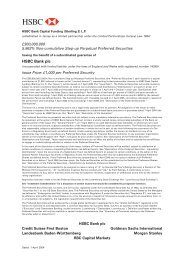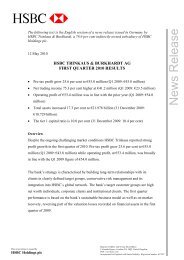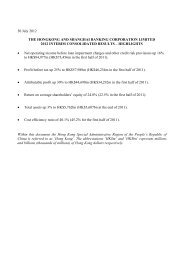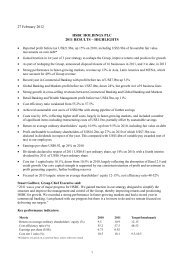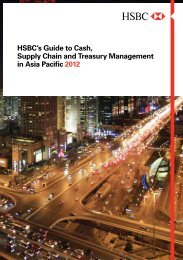HSBC Doing business in Mexico
HSBC Doing business in Mexico
HSBC Doing business in Mexico
Create successful ePaper yourself
Turn your PDF publications into a flip-book with our unique Google optimized e-Paper software.
20<br />
Transfer Pric<strong>in</strong>g<br />
Mexican transfer pric<strong>in</strong>g<br />
legislation did not comply with<br />
<strong>in</strong>ternational standards until<br />
1997. However, <strong>in</strong> December<br />
1996, the Mexican Congress<br />
enacted significant tax reform<br />
<strong>in</strong>troduc<strong>in</strong>g transfer pric<strong>in</strong>g<br />
rules consistent with guidel<strong>in</strong>es<br />
issued by the Organisation<br />
for Economic Co-operation<br />
and Development (OECD),<br />
controlled foreign company<br />
legislation, and other antiavoidance<br />
measures. These<br />
changes represented a critical<br />
stride <strong>in</strong> br<strong>in</strong>g<strong>in</strong>g <strong>Mexico</strong>’s tax<br />
rules closer to the <strong>in</strong>ternational<br />
regimes of more developed<br />
countries. To date, several<br />
m<strong>in</strong>or reforms regard<strong>in</strong>g<br />
transfer pric<strong>in</strong>g have been<br />
enacted, although the bulk of<br />
the Mexican rules are ma<strong>in</strong>ly<br />
<strong>in</strong>corporated by reference<br />
<strong>in</strong> the Mexican Income Tax<br />
Law (MILT) which requires<br />
the application of the OECD<br />
Transfer Pric<strong>in</strong>g Guidel<strong>in</strong>es<br />
to the extent consistent with<br />
the MILT.<br />
Most of the transfer pric<strong>in</strong>g<br />
rules are <strong>in</strong>cluded <strong>in</strong> Articles 86<br />
(Sections XII, XIII and XV) 215,<br />
216 and 216 BIS of the MILT.<br />
Under these rules, taxpayers<br />
are required to produce and<br />
ma<strong>in</strong>ta<strong>in</strong> documentation<br />
demonstrat<strong>in</strong>g that gross<br />
receipts and allowable<br />
deductions for each fiscal year<br />
(FY), aris<strong>in</strong>g from <strong>in</strong>ternational<br />
companies´ transactions are<br />
consistent with the amounts<br />
that would have resulted if<br />
these transactions had taken<br />
place with unrelated parties<br />
under similar conditions.<br />
Moreover, documentation of<br />
<strong>in</strong>ter-company transactions<br />
should be based on a<br />
transactional basis.<br />
All <strong>in</strong>ter-company transactions<br />
between related parties must<br />
be reported at arm’s length<br />
prices for <strong>in</strong>come tax purposes.<br />
This general rule makes the<br />
arm’s length pr<strong>in</strong>ciple the<br />
cornerstone of the <strong>in</strong>come<br />
tax system s<strong>in</strong>ce it covers<br />
transfers of tangible and<br />
<strong>in</strong>tangible property, services,<br />
domestic and cross-border<br />
transactions, transfers of shares<br />
whether publicity traded or not,<br />
entered <strong>in</strong>to by <strong>in</strong>dividual and<br />
corporate taxpayers.<br />
Article 216 specifies the<br />
follow<strong>in</strong>g six Transfer Pric<strong>in</strong>g<br />
methods:<br />
• Comparable uncontrolled<br />
price method (CUP);<br />
• Resale price method (RPM);<br />
• Cost plus method (CPM);<br />
• Profit split method (PSM);<br />
• Residual profit split method<br />
(RPSM); and<br />
• Transactional net marg<strong>in</strong><br />
method (TNMM).<br />
Taxpayers have the obligation<br />
to pay <strong>in</strong>come tax <strong>in</strong> accordance<br />
with the arm’s length pr<strong>in</strong>ciple.<br />
Additionally, taxpayers have<br />
three important transfer pric<strong>in</strong>grelated<br />
obligations:<br />
• To prepare and ma<strong>in</strong>ta<strong>in</strong><br />
transfer pric<strong>in</strong>g documentation;<br />
• To file an <strong>in</strong>formation return on<br />
transactions with non-residents<br />
related parties with the timely<br />
fil<strong>in</strong>g of their <strong>in</strong>come tax return<br />
for the previous fiscal year; and<br />
• The transfer of shares and<br />
quotas <strong>in</strong> Mexican companies<br />
between related parties is<br />
subject to special report<strong>in</strong>g<br />
requirements.<br />
Personal Income Tax<br />
Scope<br />
Resident <strong>in</strong>dividuals are<br />
taxed on worldwide <strong>in</strong>come.<br />
Non-residents are taxed on<br />
Mexican-source <strong>in</strong>come only<br />
(see above). Individuals who<br />
establish their home <strong>in</strong> <strong>Mexico</strong><br />
are considered residents<br />
if their pr<strong>in</strong>cipal centre of<br />
<strong>in</strong>terest is located <strong>in</strong> <strong>Mexico</strong>.<br />
An <strong>in</strong>dividual’s centre of vital<br />
<strong>in</strong>terest is considered to be<br />
located <strong>in</strong> <strong>Mexico</strong> when:<br />
• More than 50% of the<br />
<strong>in</strong>dividual’s <strong>in</strong>come <strong>in</strong> a<br />
calendar year is derived<br />
from Mexican sources; or<br />
• The centre of the <strong>in</strong>dividual’s<br />
professional activities is located<br />
<strong>in</strong> <strong>Mexico</strong>.<br />
A taxpayer may be a salaried<br />
employee or self-employed<br />
with <strong>bus<strong>in</strong>ess</strong> <strong>in</strong>come.<br />
The first k<strong>in</strong>d of <strong>in</strong>come<br />
<strong>in</strong>cludes salaries, wages,<br />
director’s fees, bonuses,<br />
gratuities, allowances, certa<strong>in</strong><br />
fr<strong>in</strong>ge benefits <strong>in</strong> k<strong>in</strong>d and<br />
statutory employees’ profit<br />
shar<strong>in</strong>g distributions.<br />
The second k<strong>in</strong>d, i.e. parties<br />
earn<strong>in</strong>g <strong>in</strong>come from <strong>bus<strong>in</strong>ess</strong><br />
activities or professional<br />
services, <strong>in</strong>clud<strong>in</strong>g real estate<br />
rental activities, is subject to<br />
tax at the rates established <strong>in</strong><br />
the law and published by the<br />
tax authorities.<br />
The <strong>in</strong>dividual tax rate is<br />
graduated with a maximum<br />
rate of 30% for the next two<br />
years (2011 and 2012).<br />
For <strong>in</strong>dividuals, the fiscal year<br />
<strong>in</strong> <strong>Mexico</strong> is the calendar year.<br />
Tax returns must be filed <strong>in</strong><br />
April (no later than 30 April)<br />
of the follow<strong>in</strong>g year. Selfemployed<br />
<strong>in</strong>dividuals and those<br />
with rental or <strong>bus<strong>in</strong>ess</strong> <strong>in</strong>come<br />
must file monthly returns<br />
no later than the 17th of the<br />
month follow<strong>in</strong>g the one <strong>in</strong><br />
which the <strong>in</strong>come is received.<br />
Payment must be made at<br />
a bank or via the Internet,<br />
as applicable. Employees of<br />
foreign companies who work<br />
<strong>in</strong> <strong>Mexico</strong> must make monthly<br />
estimated tax payments if<br />
their companies do not have<br />
permanent establishments<br />
<strong>in</strong> <strong>Mexico</strong>.<br />
Parties receiv<strong>in</strong>g salary and<br />
<strong>in</strong>terest <strong>in</strong>come exceed<strong>in</strong>g<br />
Mex$400,000 are not required<br />
to file annual tax returns.<br />
However, if the real amount of<br />
<strong>in</strong>terest exceeds Mex$100,000<br />
and tax is withheld on that<br />
<strong>in</strong>terest, the <strong>in</strong>dividual must<br />
file an annual tax return.<br />
Personal <strong>in</strong>come taxes of<br />
resident and non-resident<br />
employees are frequently<br />
withheld. An <strong>in</strong>dividual resident<br />
taxpayer may elect to pay the<br />
rema<strong>in</strong><strong>in</strong>g tax due either when<br />
the annual return is filed or <strong>in</strong><br />
<strong>in</strong>stalments with <strong>in</strong>terest over<br />
a six-month period.<br />
Resident <strong>in</strong>dividuals must<br />
<strong>in</strong>clude all <strong>in</strong>formation with<br />
their annual <strong>in</strong>come tax return,<br />
<strong>in</strong>clud<strong>in</strong>g exempt and nontaxable<br />
<strong>in</strong>come. In addition,<br />
resident <strong>in</strong>dividuals must<br />
<strong>in</strong>clude <strong>in</strong>formation regard<strong>in</strong>g<br />
their <strong>in</strong>come from donations,<br />
prizes and loans received<br />
dur<strong>in</strong>g the calendar year,<br />
when it exceeds separately<br />
or <strong>in</strong> the aggregate.<br />
The employer must pay<br />
Social Security feeds and<br />
Workers’ Hous<strong>in</strong>g Fund feeds,<br />
as well as the mandatory<br />
pension plan, accord<strong>in</strong>g to<br />
Mexican Legislation.



